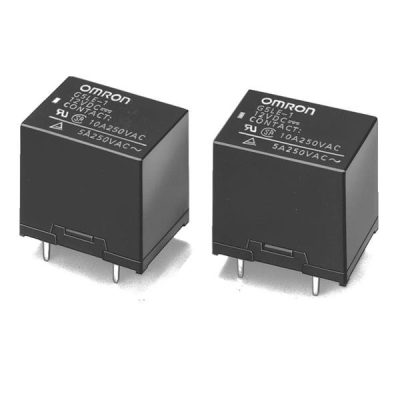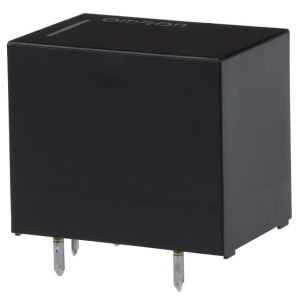G5LE-14-DC24
Part Number: G5LE-14-DC24
Manufacturer: OMRON Electronic Components LLC
Description: Power Relay 24VDC 8DC/10AAC SPDT(22.5×16.5×19)mm THT
Shipped from: Shenzhen/HK Warehouse
Stock Available: Check with us
ICRFQ.com - Electronic Components Distributor in China Since 2003

Part Number: G5LE-14-DC24
Manufacturer: OMRON Electronic Components LLC
Description: Power Relay 24VDC 8DC/10AAC SPDT(22.5×16.5×19)mm THT
Shipped from: Shenzhen/HK Warehouse
Stock Available: Check with us
In the G5LE series of relays, the G5LE-14-DC24 is a 1-pole cubic Power PCB Relay with a DC coil. PCB terminals feature an SPDT contact arrangement. The basic model features UL class-B insulation for the coil. UL, CSA, and EN standards have been met, and it complies with the Electrical Appliances and Material Safety Law (300V maximum). Completely airtight container Applications for Consumer Electronics, Industrial Automation and Process Control, Power Management, and Consumer Electronics Coil Voltage 24VDC SPDT for the Contact Form (1 Form C) Evaluation of Contact (Current) 10A Maximum Coil Voltage of 125VDC, with a Switching Voltage of 250VAC Temperature Range for Non-Latching Operations: -25°C to 85°C

The magnetic in this switch allows it to either completely close or open a circuit. An armature, contacts, an electromagnet, and a spring are the primary components it uses. In most cases, the power source for a power relay is the battery, and the electromagnet is responsible for drawing the armature. In addition, it features an iron arm that can be moved. The armature is maintained in its position by the use of a spring. To make contact and complete the circuit, the armature is pulled directly in the direction of the coil.
The armature will be pulled away from the contact while the relay is in the closed position because the coil will pull on it. This will break the connection in the circuit. A power relay can be operated successfully even when the voltage is low. On the other hand, a power relay switch may be the best option in environments with high voltage. Because of this one-of-a-kind characteristic, a power relay is suitable for various applications.
A power relay has applications across a variety of business sectors. Amplification of sound and telephone systems could benefit from the employment of these switches. They are also helpful in computer systems and the electronic systems found in automobiles.
This endeavour aims to transmit any signal from one circuit to another. In addition, autos feature a plethora of electrical components, systems, and systems. The power source for each of them is a battery with a voltage of 12 volts. As a result, power relays can be the perfect choice for these applications.
Some automobiles will include more than twenty power relays, which control various features, including the horn, the windshield wipers, and the power train system.
An automobile will likely have several different functions. All of them are under the supervision of a computer. Additionally, it controls the engine. On the other hand, there will be a module for controlling the engine. This will manage the engine as well as the functions associated with it.
The Engine Control Module, sometimes known as the ECM, will be responsible for monitoring the functioning. In addition, it will regulate the flow of power to the fuel injection and fuel delivery systems. It will test the engine’s timing, emissions, ignition, exhaust gas circulation, and other functions within your car. However, the ECM will need electricity access to send it to each system.
Under the hood of a car is where you will discover the power distribution centre of that vehicle. It can regulate every relay and fuse in a vehicle. Both the PCM power relay and the ECM power relay perform the function of a switch and are responsible for transferring power to the ECM. On the other hand, if the ignition key is turned off, the power relay for the PCM will not supply the switches with battery power. As a direct consequence, your car’s functionality will be compromised.
Additionally, the device cannot power the ECM if a PCM relay is still open. As a result, you are unable to start your car. It will continue to be closed, allowing excessive electricity to enter the ECM. That will cause the battery to deplete.
It functions as an electrical switch by using an electromagnet. An electrical signal of low power is what turns on the electromagnet. A microcontroller is where the signal originates. When the electromagnet is turned on, it will pull to either close or open an electrical circuit.
A wire coil with a wrapped solenoid or soft iron core is what makes up a relay. Additionally, an iron yoke will give sets of contacts, a moving iron armature, and a low route for the magnetic flux. The mobile armature will be fastened to the collar before connecting to contact or contacts.
A spring holds them in place, and if the relay loses power, the armature will break the magnetic circuit. Currently, one or more contacts will be closed. At the same time, some will continue to be open.
The armature will be triggered into action by the magnetic field created by the current flowing through the coil. The usually stationary contacts will be broken or reconnected when in motion. The relay’s open and closed contacts will become unconnected if the relay loses power.
When the power is cut, the armature will automatically return to its resting position. The force is supplied by a spring, though gravity is also an option. Power relays typically have a quick operation time and are helpful in various contexts. On the other hand, high current uses necessitate the highest quality components.
This device, which acts as a directional protection relay, is to block electricity from being accidentally sent in the opposite direction. These relays are helpful when one generator operates in parallel with another generation or utility. In the event of an output failure, it will prohibit electricity from another generator or utility from flowing back to the active generator.
The relay is responsible for power monitoring. When the generator’s output drops below a certain threshold, it promptly cuts power to the generator so that the stator coil doesn’t overheat.
It is also possible that problems with the engine, prime mover, or turbine that powers the generator will render that component ineffective. If the prime mover stops working, the generator will stop producing electricity, and the system may start using power from other sources. The generator will be shut off if the reverse power relay detects a change in the direction of the power flow.
Thanks for reading. Please post any questions you may have in the box below comments, and we will try to respond. Contact ICRFQ, your top electronic distributor in China, for more information about G5LE-14-DC24, and allow us to assist you in obtaining the best product at a fair price.
WhatsApp us